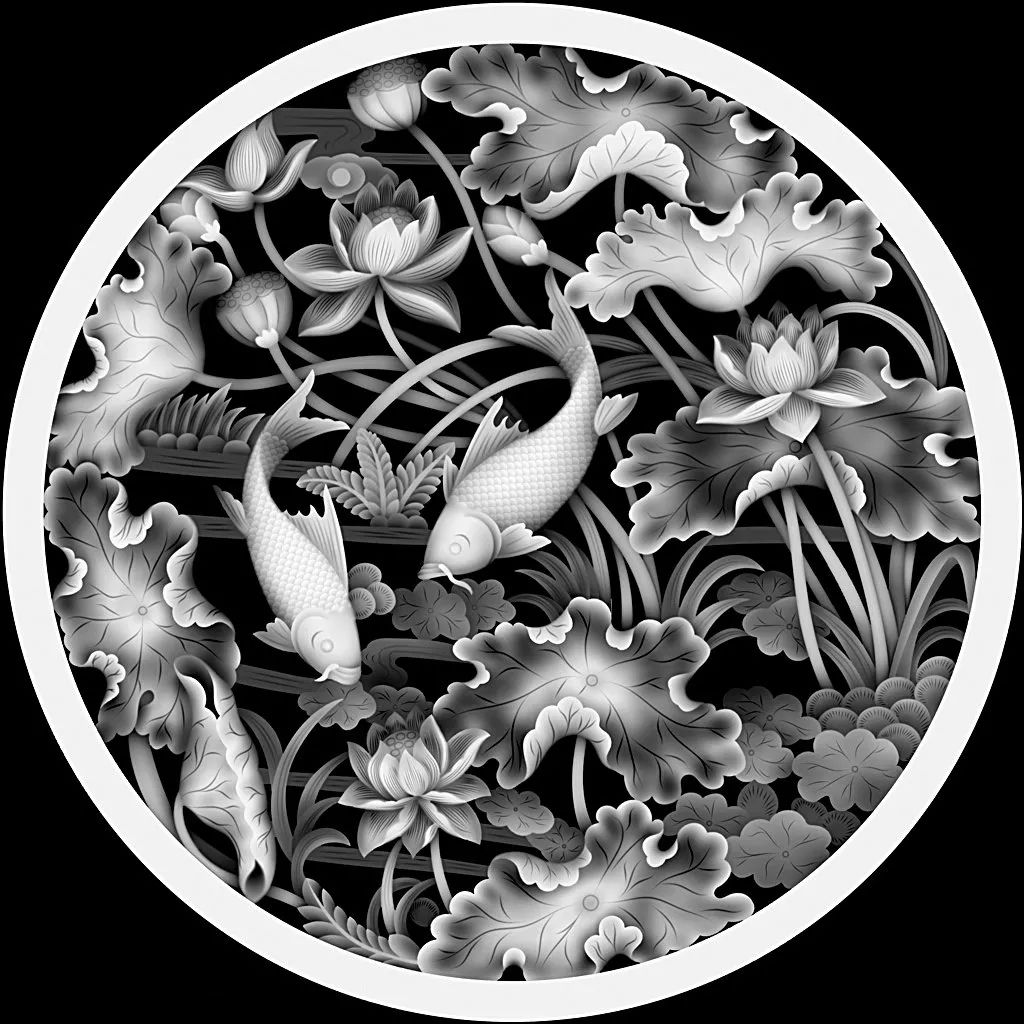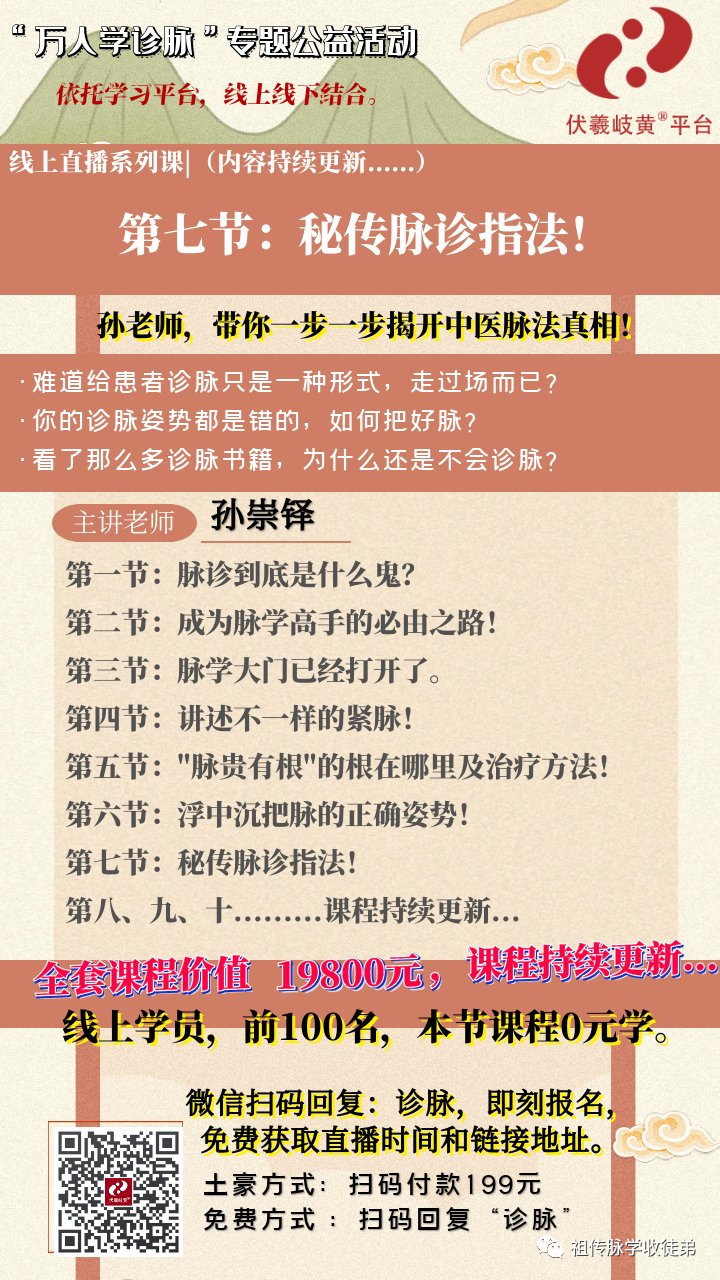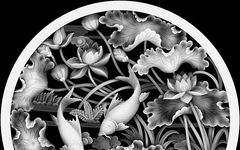Overview of Pulse Diagnosis
1、Floating Pulse Guidelines:Lightly press for floating, heavy press for none; floating like wood floating in water, strong floating indicates wind-heat, weak floating indicates blood deficiency. For the sinking pulse, press heavily to reveal it, like a stone sinking in water; strong sinking indicates cold pain, weak sinking indicates deficiency-cold. For the slow pulse, it comes slowly, three beats per breath; remember the extremely slow pulse, it indicates organ disease or excess cold, carefully study the balance of deficiency and excess.
2、First, clarify the principle of pulse movement; memorizing over twenty pulse types is not sufficient. The pulse movement is the arterial pulse, which belongs to Yang; pulse taking is actually feeling the rise and fall of Yang Qi within the body. Venous blood returns through the inferior vena cava to the right atrium, then into the right ventricle, and then through the pulmonary veins into the lungs, where red blood cells combine with oxygen atoms before entering the left atrium, then the left ventricle, and finally the aorta to supply other organs. The pulse taken at the cun (寸) position specifically refers to the radial artery pulse, which is the starting point of the Taiyin Lung Meridian. The three positions and nine pulses refer to feeling the arterial pulse at other parts of the body where the organs and meridians circulate. The lungs are where red blood cells combine with oxygen atoms; the body’s operation is a continuous process of oxidation and reduction, so changes in the lung pulse reflect overall changes in the body, guiding how to adjust the body’s Yin and Yang. You can imagine blood vessels as water pipes; under normal conditions, water flows through the pipe, with pressure near the walls representing Yang Qi, and lower pressure in the center representing Yin blood. If Yin is deficient, a light touch can feel the pulse (floating pulse, fine pulse). If Yang is deficient, the wall pressure is low, and deeper pressure is needed to feel the pulse (sinking pulse, stone pulse). If blood is insufficient, Qi loses its nourishing ability, leading to both Qi and blood deficiency, resulting in sluggish flow (rough pulse, hollow pulse). In chronic illness, Qi deficiency leads to low pulse pressure (fine pulse, small pulse), and blood flow slows (slow pulse, gentle pulse). Yin deficiency with Yang excess (rapid pulse, long pulse) leads to blood stagnation (bound pulse, intermittent pulse). Wind, as a Yang pathogen, can cause the pulse to beat too forcefully; cold, as a Yin pathogen, has a constricting nature that can make the pulse tight; fire, as a Yang pathogen, can cause the pulse to beat rapidly; dampness, as a Yin pathogen, can slow the pulse or cause it to pause; heat, as a Yang pathogen, often accompanied by dampness, can make the pulse tight, small, slow, and rough.

Guidelines
The method of pulse taking has true transmission; the twenty-eight pulses are not ordinary,
Floating, sinking, slow, and rapid pulses must be carefully studied,
Floating includes five pulses that must be clearly examined (soft, leather, surging, fine, scattered)
Sinking includes four pulses that must be heavy (hidden, fine, firm, weak)
Floating and sinking, four pulses in total. (deficiency, excess, hollow, long)
Floating Pulse
Lightly press for floating, heavy press for none; floating like wood floating in water,
Strong floating indicates wind-heat, weak floating indicates blood deficiency.
Sinking Pulse
Press heavily to reveal the pulse; like a stone sinking in water,
Strong sinking indicates cold pain, weak sinking indicates deficiency-cold.
Slow Pulse
Slow pulse comes, three beats per breath; remember the extremely slow pulse,
Slow pulse indicates organ disease or excess cold; carefully study the balance of deficiency and excess.
Rapid Pulse
Rapid pulse comes, six beats per breath; remember the rapid pulse,
Floating and sinking, deficiency and excess must be distinguished; the fire of the monarch and minister is treated differently.
Deficient Pulse
Deficient pulse is weak, all without strength; floating large and soft without root,
Deficient pulse with body heat indicates heat stroke; Qi deficiency leads to weakness.
Excess Pulse
Excess pulse is large and long; three positions filled with strength,
New illness shows excess evil Qi; chronic illness shows the disease is ominous.
Slippery Pulse
Slippery pulse is smooth, requiring guessing; like beads rolling on a plate,
Food stagnation and phlegm heat fill the chest; women’s pulse should be adjusted during pregnancy.
Rough Pulse
Rough pulse is like bamboo scraped; fine, slow, and short, resembling a desire to stop,
Blood deficiency and dryness lead to Qi and blood stagnation; women not pregnant may have no menstruation.
Surging Pulse
Surging pulse is full, like waves; when it comes, it is abundant, but when it goes, it is calm,
Surging indicates the disease is progressing with excess evil Qi; fullness in the stomach is difficult to treat.
Fine Pulse
Fine pulse is like silk, pressing feels like nothing; wanting to stop but not stopping,
Five labors and six extremes lead to various deficiency diseases; sudden illness has little hope for recovery.
Tight Pulse
Tight pulse is like a rope; it is a pulse shape, tight and urgent,
Cold injuries lead to internal and external pain; floating and sinking must be clear.
Slow Pulse
Slow pulse is four beats; it is a pulse shape, calm and gentle,
May be due to spleen deficiency or wind-damp disease; it is a disease, not a disease, carefully assess.
Soft Pulse
Soft pulse is floating, gentle, and fine; floating on the water, weak and powerless,
Postpartum illness can still be seen; healthy individuals without roots should worry.
Weak Pulse
Weak pulse is soft and fine; like cotton in water, lacking strength,
Yang Qi is weak and essence-blood is deficient; the elderly may still have it, but the young may not.
Long Pulse
Long pulse is long and distant; pressing down feels soft and precious,
Long indicates the heart and kidney are fundamentally strong; long and hard indicates the sin of fire.
Short Pulse
Short pulse is short and retracted; like a turtle, hiding its head and tail,
Short indicates various diseases are difficult to treat; due to the loss of true Yuan Qi.
Hollow Pulse
Hollow pulse is empty in the middle; pressing feels soft like scallions,
Fire invading the Yang meridian leads to blood overflow; heat injures the Yin meridian leading to red flow.
String-like Pulse
String-like pulse is straight and taut; it feels like a guitar string,
String-like indicates liver and gallbladder phlegm and pain; light and heavy must be distinguished.
Scattered Pulse
Scattered pulse is floating and chaotic; in the middle, it gradually disappears,
Childbirth indicates a birth sign; prolonged illness indicates the soul is about to break.
Fine Pulse
Fine pulse is fine as a thread; sinking feels extremely fine and never breaks,
Worry and labor lead to Qi and blood deficiency; dampness and evil stagnation are also common.
Hidden Pulse
Hidden pulse requires careful seeking; pressing down feels like touching bones,
Qi stagnation and cold lead to internal accumulation; wanting to vomit but unable to due to evil closure.
Arterial Pulse
Arterial pulse has no head or tail; its movement is like beans; it shakes and sways,
Arterial pulse indicates pain and fright; the Shaoyin pulse is very active during pregnancy.
Leather Pulse
Leather pulse is floating and urgent; pressing feels empty, like pressing a drum skin,
Women may experience postpartum bleeding; men may suffer from nutrient deficiency or nocturnal emissions.
Firm Pulse
Firm pulse is sinking and strong; it feels solid and large,
Accumulation leads to internal cold pain; running piglet syndrome leads to disaster.
Rapid Pulse
Rapid pulse is quick, stopping at intervals; like a horse running, occasionally stumbling,
Intense fire leads to loss of body fluids; wheezing and coughing indicate urgent toxicity.
Bound Pulse
Bound pulse is slow, stopping at intervals; it feels like a slow walk,
Bound pulse indicates Yin cold, also due to accumulation. Left cun indicates heart cold, pain can be resolved; right cun indicates lung deficiency, Qi cold accumulation; left guan indicates hernia; right guan indicates phlegm stagnation and food retention. Left chi indicates weakness; right chi indicates Yin cold as a burden.
Intermittent Pulse
Intermittent pulse is a replacement; it has a constant number; it cannot return by itself, and takes a long time to move again.
Intermittent pulse indicates organ decline, a sign of danger. Spleen deficiency leads to vomiting and diarrhea; cold in the middle leads to difficulty in eating; two movements and one stop indicate death in three to four days; four movements and one stop indicate death in six to seven days. Sequentially push for inquiry, do not lose the essence.
Leather Pulse
Leather pulse is large and urgent; floating feels immediate; pressing feels empty, like a drum skin.
Leather pulse indicates exterior cold, also belongs to middle deficiency. Left cun indicates heart blood deficiency pain; right cun indicates metal deficiency and Qi stagnation. Left guan indicates hernia; right guan indicates earth deficiency pain. Left chi indicates leather pulse, essence empty; right chi indicates leather pulse, death is a concern. Women may experience postpartum bleeding.
Firm Pulse
Firm pulse is in the sinking position, large and string-like; floating in two positions, it is difficult to obtain.
Firm pulse indicates accumulation; the disease is internal. Left cun indicates hidden illness; right cun indicates breath can be determined. Left guan indicates liver blood accumulation; right guan indicates Yin cold and fullness. Left chi indicates firm pulse, running piglet is a concern; right chi indicates firm pulse, hernia pain is severe.


